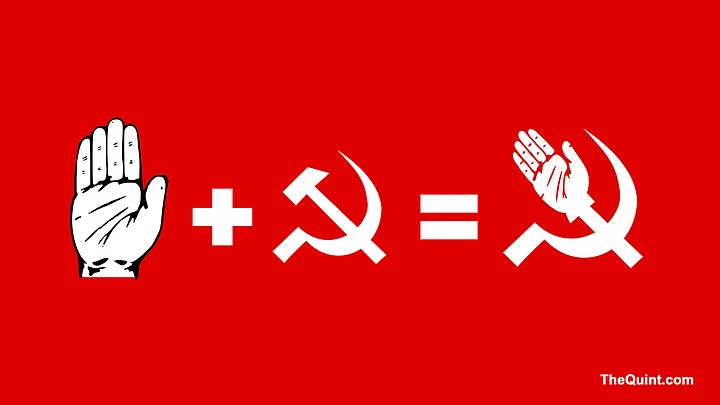In 2011, the Trinamool Congress (TMC) broke 34 years of Left rule in West Bengal in a feat of sorts in India’s election history. Mamata Banerjee made massive inroads in the Left’s support base. The Congress joined hands with her in these elections against the Left Front. One may recall, these elections followed the severe anger generated by Singur and Nandigram where the Left government’s efforts at industrialisation through land acquisition had backfired. The TMC reaped the profits of the loss of rural support to the Left. From then on there was no looking back for the TMC.
Now the 2016 assembly elections in the state have brought the Left and the Congress together. Both were faced with extinction at Didi’s hands. This mahajot is similar to the RJD and JD(U) partnership with the Congress in a mahagathbandhan in Bihar. The reasoning being that an alliance is the only way to take on a powerful opponent lodged firmly in power. Of a total of 294 seats in Bengal, the Left Front is contesting about 200 and the Congress 80.
Combating the BJP
Political compulsions have brought rivals together. The first-past-the-post system necessitates forming alliances between parties to win seats when there is a strong opponent and chances of winning power in a solo act are slim. Seat level partnerships eliminate a situation of division of votes and ensure their accumulation that bolster chances of victory.
The Left is feeling the need to resuscitate itself in its former bastion that would in turn help revitalise its fortunes country-wide. The same goes for the Congress: if this alliance works well, there would be gains at the national level. The goal to weaken the BJP nationally, through heaping defeats on it in the states, has spurred both the Left and Congress in the last couple of years.
Besides the political reasons, which in any case are well known, we must see whether there is an ideological basis for rivals to become political partners. Going into this is important as many political commentaries have foregrounded that the ideological basis for a Left-Congress combine is very weak as they occupy opposite poles of the ideological spectrum. In the face of such arguments, highlighting the ideological basis of such a partnership assumes significance.
Ideological Common Ground
- The driving force behind Left-Congress
combine is to provide a secular non-Hindutva alternative.
- While leading UPA-I and UPA-II, Congress moved
towards a more poor-oriented or left-of-centre position.
- Moving to a more left-of-centre position has
made it less difficult for the Left to align with the Congress.
- Left has drifted away from a position of
communist takeover of the state to more welfare-oriented stances within a
liberal-democratic state.
- This change of stand makes it easier for the
Congress to align with the Left.
Left-Congress Combine’s Ideological Basis
To begin with, an ideological common ground which brings the LF and the Congress together, after the BJP’s victory at the national level, is the defeat of communal forces and giving a secular non-Hindutva alternative to citizens. This alternative politics combined with its liberal values of free expression, right to religious freedoms, right to personal preferences in food, dress, etc. is something that has expanded the ideological possibility for the Left and the Congress to join hands now and in the future.
Related to this is the fact that the centrist Congress, while leading UPA-I and UPA-II, moved towards a more poor-oriented or left-of-centre position. This was manifest in its enactment of right to information, rural employment guarantee, right to education and other schemes. Moving to a more left-of-centre position has made it less difficult for the Left to align with the Congress.
The Left on its part has had a stable base (though facing erosion every now and then) countrywide among the working class in the organised sector, and a base among the West Bengal peasantry. Ideologically, it has veered more towards a stance that seeks egalitarianism, inclusiveness and plurality at the policy level. It has moved away from a totalist position of communist takeover of the state to more welfare-oriented stances within a liberal-democratic state. This makes it easier for the Congress to align with the Left.
This shift of the Left and the Congress from their established ideological positions towards what can be called social-democrat goals that foreground rights of the marginalised without destabilising constitutional democracy have expanded possibilities of alliances between them.
Alliance of Left-Of-Centre Parties
The two in fact had aligned during UPA-I and had hammered out a common minimum programme oriented towards strengthening the rights of the underprivileged. The alliance, however, broke, of all matters, on the nuclear deal. Alliances such as these, especially between left-of-centre parties and the Left/communists are not unprecedented. In European democracies there have been several instances of alliances between the Social Democrats and the Left (often joined by Green parties) where they have taken on the right-of-centre parties in elections.
In West Bengal, desperate conditions have helped fructify the jot. But this does not hold true for Kerala. It needs to be seen whether the Left would be able to balance this contradiction between Kerala and West Bengal. Secondly, the Left is known to have national ambitions and has historically punched above its weight.
If the partnership is successful in West Bengal, and Sitaram Yechury demands his pound of flesh in states where the Congress is the main challenger to the BJP, will the young architect of alliances in the Congress be willing to share with the communists the party’s already shrinking electoral fortunes? This remains to be seen.
(The writer is author of ‘Vishva Hindu Parishad and Indian Politics’ and teaches political science at the University of Hyderabad)
Also read:
In Poll’s Decisive Phase, Questions Over Mamata’s Moral Authority
In Mamata Banerjee’s Kolkata Bastion, Is Trinamool in Trouble?
